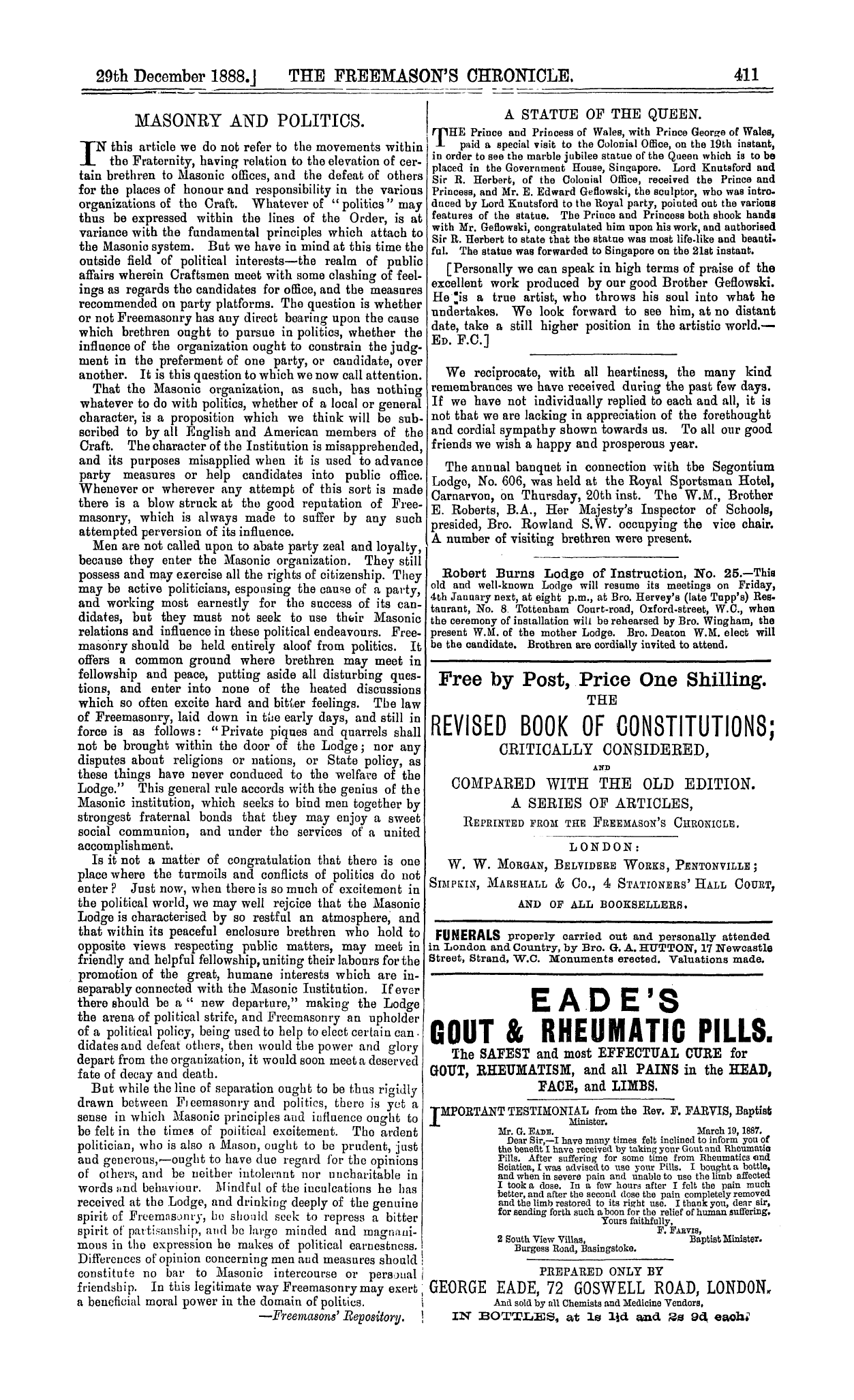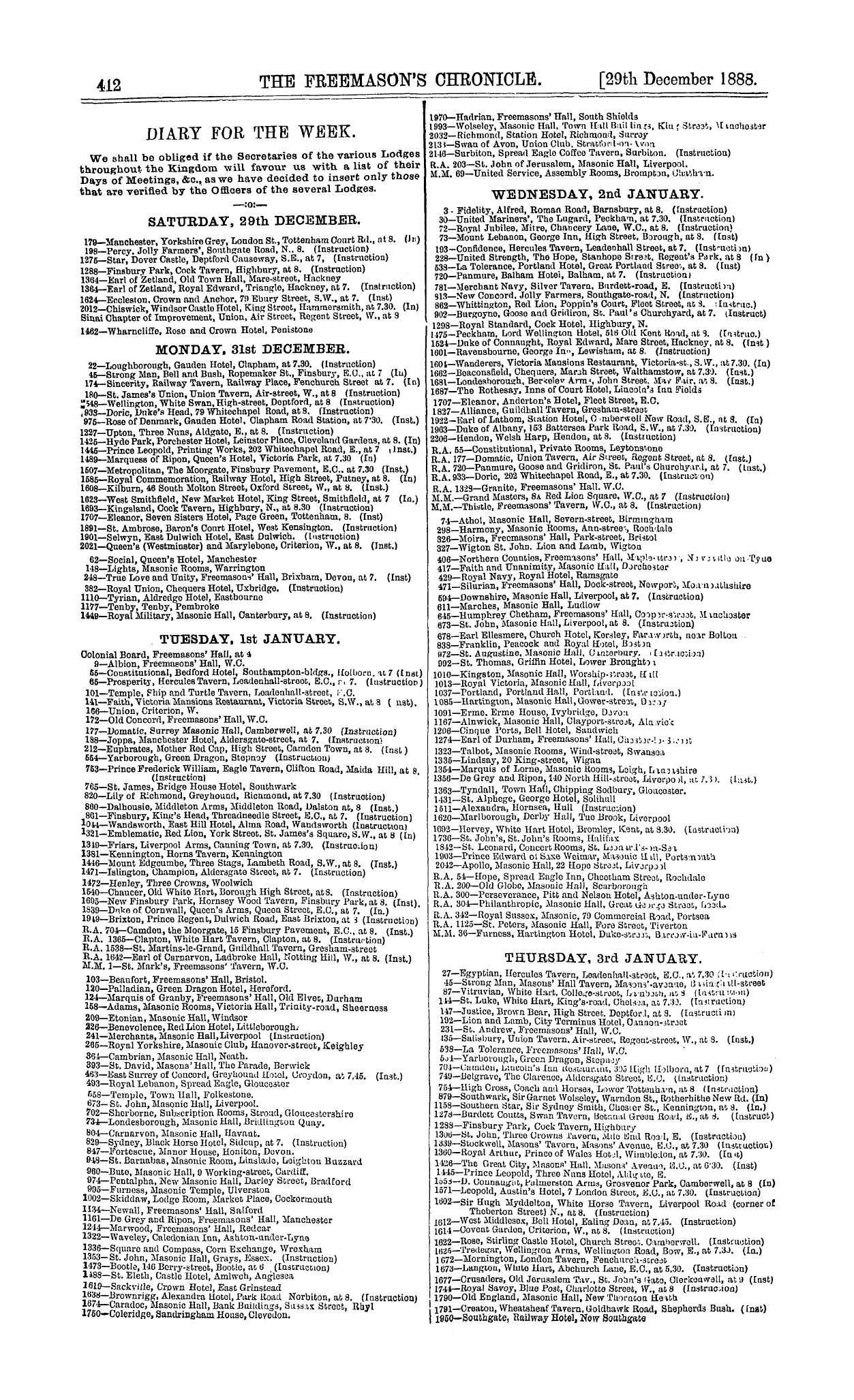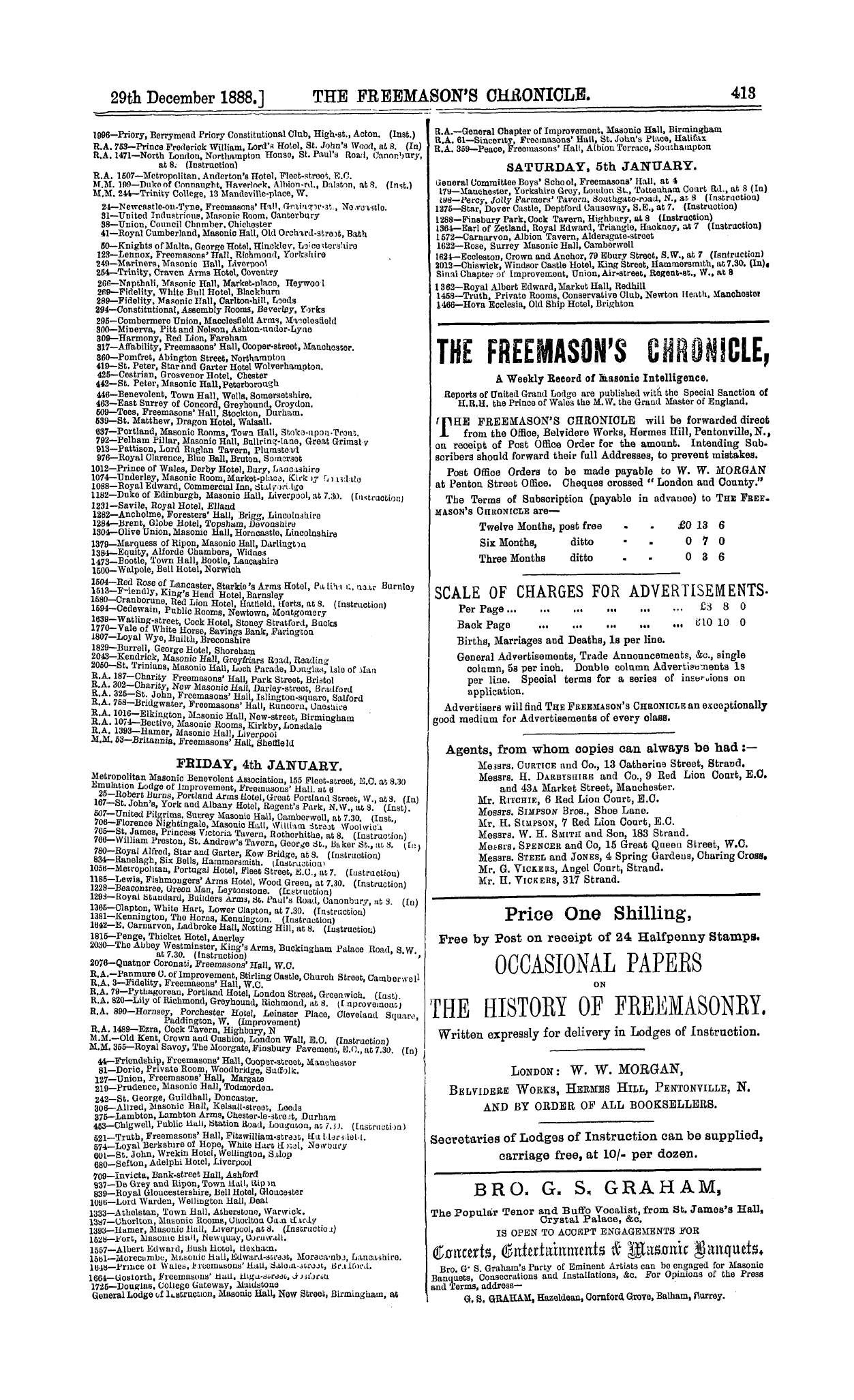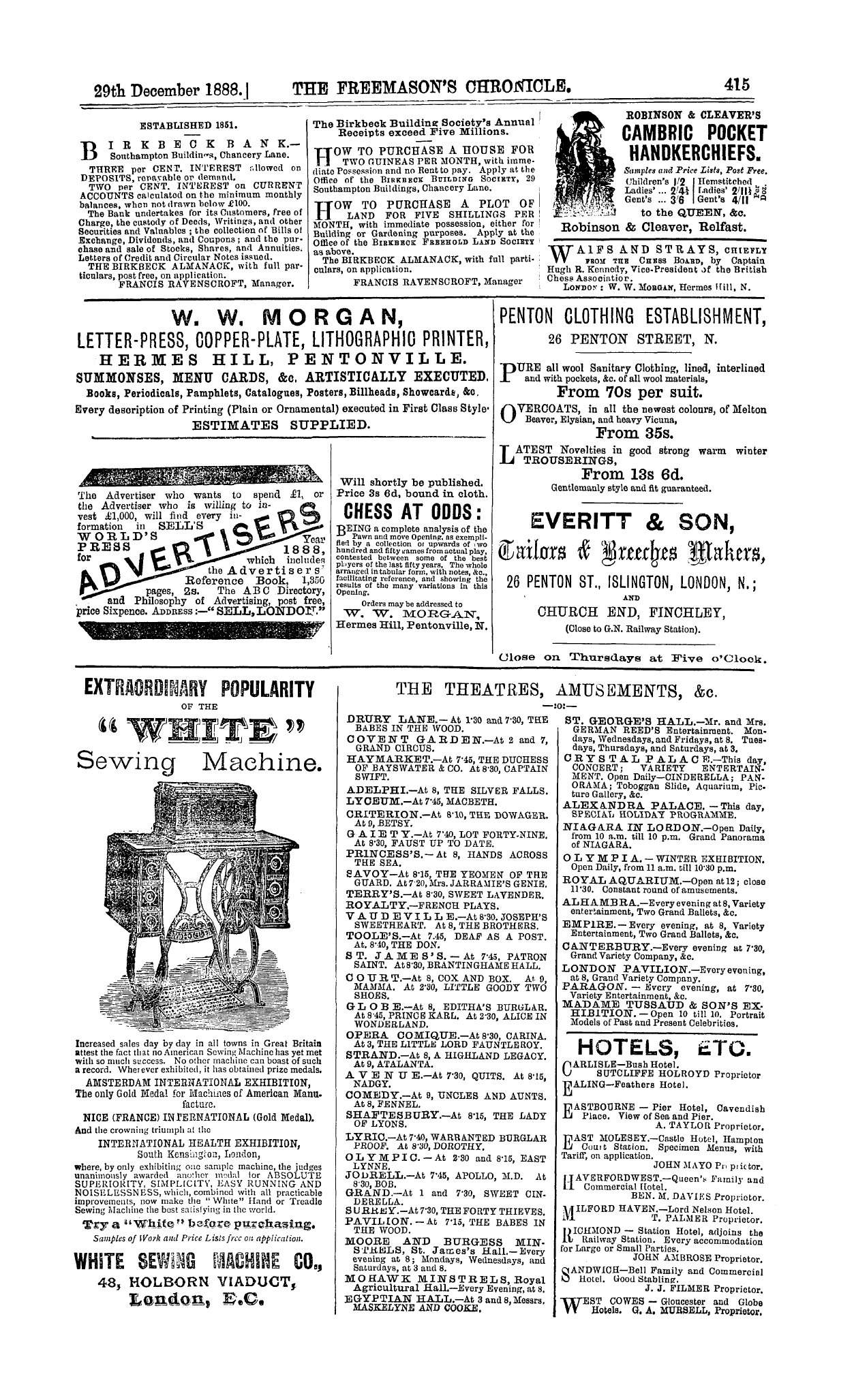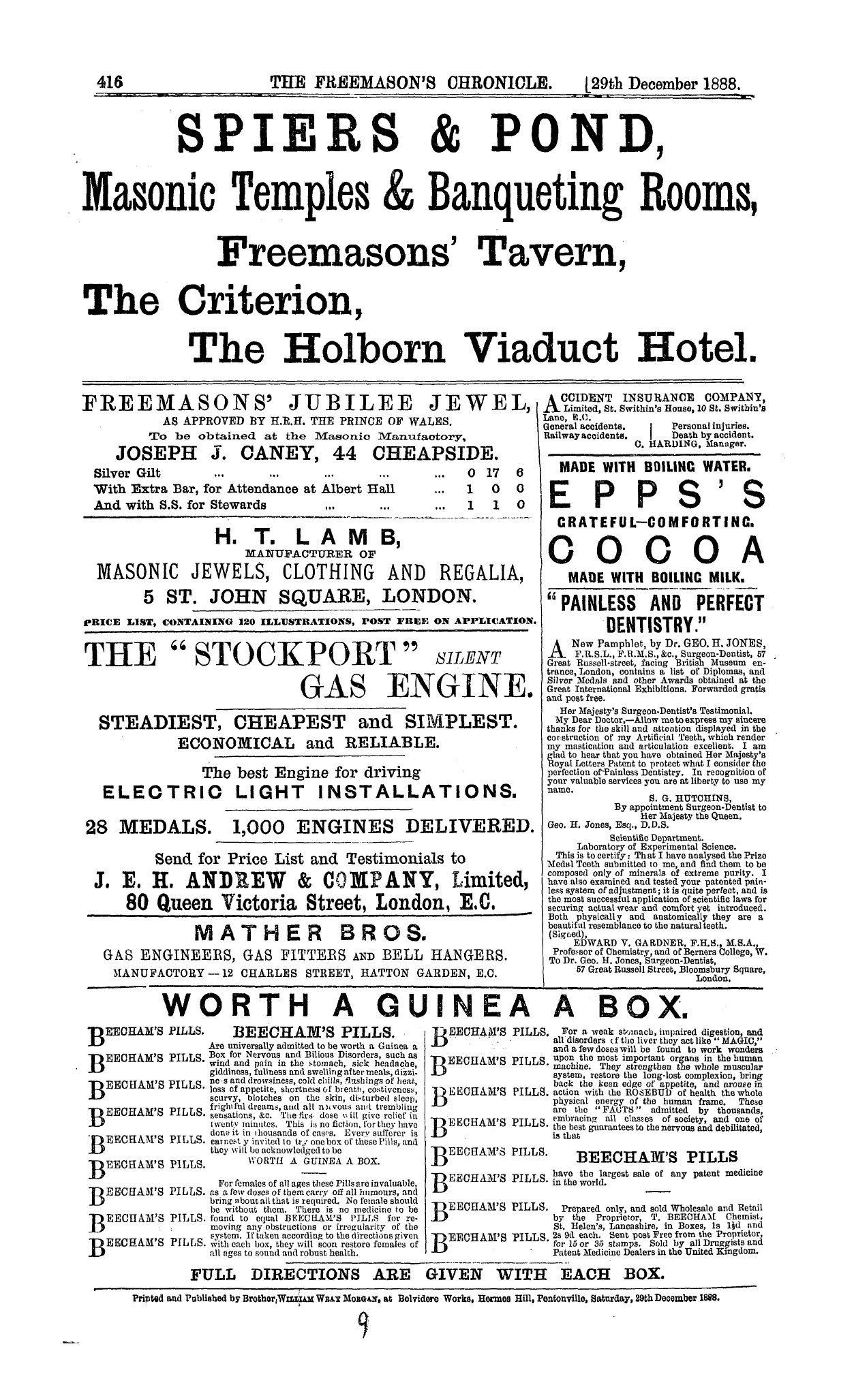Note: This text has been automatically extracted via Optical Character Recognition (OCR) software.
Brother Sadler's Answer To Bro. Jacob Norton's Comments On Facts And Fictions."
BROTHER SADLER'S ANSWER TO BRO . JACOB NORTON'S COMMENTS ON FACTS AND FICTIONS . "
( Continued from page 390 . ) BROTHER Norton will not , I trust , feel offended with me if I pass lightly over the numerous references to rituals , & c , contained in his article of the 27 th of
October ; the pamphlets from which he derives his knowledge are in my opinion too unreliable and partake too much of the catchpenny character to be of any real value in a discussion such as ours . I must therefore decline
any further allusion to them , but if my good old friend will reserve his judgment on that class of evidence until we meet again on this side of the water , I may be able to put him right on at least one point which he has mentioned .
It would bo extremely gratifying to me if I could but find in Bro . Norton ' s " Comments " something that would enable us to meet on level ground , as it were , and enjoy a real brotherly " shake " of sympathy and cordial
agreement , and indeed I waa under the impression that I had reached that delightful stage when I read , in his first article , that the Irish Grand Lodge derived all its ceremonies from the London Grand Lodge ; but when , in his
second article , he tells us that " the installation of Masters , with words , signs and grips thereunto belonging , was an early Irish invention , and so were the Officers known as . ' Senior and Junior Deacons , '" I find we are
nearly as far apart as ever ; and yet it is only the one little word " invention" that separates us . I am curious to know what authority other than Bro . Norton ' s
imagination there is for saying that the ceremony referred to was an Irish invention ; if he turns to pages 34 and 196 of that troublesome book of mine be will find that allusion
is made to a postscript to the Constitutions of 1723 , and if he compares that Postscript with " The antient manner of constituting a Lodge " iu Spratt's Irish Constitutions , I think he will admit that there exists a strong family
likeness ; and if he makes a comparison between " Spratt , Anderson ' s edition of 1738 , and Dermott ' s " Ahiman Rezon , " he will find a still closer resemblance . In each of the books named the ceremony of installation is
described quite as clearly as I should expect to find it in an authorised publication , and unless Bro . Norton can produce evidence that this ceremony was practised in Ireland prior to 1723 I shall prefer to believe that it was
not an " Irish invention , but that it was taken from England originally , and was afterwards restored by the Irish Masons , or " Ancients , " when the English Fraternity had neglected to practise it for so long a period that it was quite unknown to the general body of
the Craft . I am sorry to say I cannot accept the assertion that the
Moderns never had a ceremony of installation , for it appears to me to be of a similar character to many other of Bro . Norton ' s assertions , i . e ., it is contrary to evidence . In
order to enable those who have not access to the books just mentioned to judge for themselves , I will quote a paragraph from the Postscript to the Constitutions of 1723 . " Upon this the Deputy shall rehearse the Charges of a
Master , and the GRAND MASTER shall ask the candidate , saying , Do you submit to these Charges , as MASTERS have
done in all Ages ? And the candidate signifying his cordial submission thereunto , the GRAND MASTER shall by CERTAIN significant ceremonies and ancient usages install him , and present him with the Constitutions , the Lodge Book , and
the instruments of his office , not altogether , but one after another ; and after each of them , the Grand Master , or his Deputy , shall rehearse the short and pithy Charge that is suitable to the thing presented . " I am quite unaware of
the extent of Bro . Norton s knowledge of the English ceremony of installation , for I have no recollection of the subject ever having been mentioned , either in our
correspondence or on the occasions of our meeting , but having myself had some years of practice , I may observe that this quotation seems to bear a very striking resemblance to a portion of the authorised ceremony of the present day .
If I am not mistaken there is in Boston an excellent
Masonic Library , to which Bro . Norton is at all times welcome , and , although I know him to be a very busy man , yet I think it will be worth his while when he can spare a few hours to carefully read the whole of this postscript and also the descriptions in the Constitutions of the Annual
Brother Sadler's Answer To Bro. Jacob Norton's Comments On Facts And Fictions."
Grand Feasts . Prior to 1717 he will find a long list of
persons of one sort or another who are said to have been Grand Masters ; this Bro . Norton knows as well as I do , but he may not have remarked that none of these personages are represented to have been installed ; indeed , the
word is not used at all , so far as I can see . At the Feast in 1717 , and for several years afterwards , the Grand Master , if present at the Annual Feast , is said to have been " installed . " According to the written minutes of Grand
Lodge , the last Grand Master of that period to whom this term is applied is Viscount Montague , who was installed on the 18 th April 1732 ; from thence till 1782 the word is only used once , and that is in 1764 , when John Revis was
installed as proxy for Lord Blayney . And in 1782 the Earl of Effingham went through a similar process for the
Duke of Cumberland . Here then , in my opinion , is fairly conclusive evidence that in the early days of the Grand Lodge the " Moderns " had a ceremony of installation for private Lodges as well as
for the Grand Lodge ; but why they were discontinued I can only surmise . In the latter case it could not have been out of consideration for the appetites of the brethren as the ceremony always took place after dinner . A possible clue may be found in the following incidents : —
In 1730 the Duke of Norfolk is not stated to have been installed , but only " declared " Grand Master ; his
predecessors had all been installed , and in 1731 , Lord Lovell , his successor , was " so very ill of an Ague that he was obliged to return home , but that he had appointed the Right Hon , the Lord Coleraine to be his Proxy for that day . " After
dinner Lord Coleraine was accordingly invested with the Badge of Grand Master as Proxy for Lord Lovell . It may be that finding that these two got on very well without a
formal ceremony of installation the brethren did not attach any importance to that function , for although the next Grand Master , Lord Montague , is said to have been " install'd , " his immediate successors are all described as
having merely been " invested , " or " declared . " Private Lodges would probably follow the Grand Lodge in this respect , and in course of time the ceremony of installation was no longer deemed a part of the modern system of Freemasonry .
As for my trying to prove " that the Ancients' form of Installation was truly ancient , or even as old as 1723 , " I am not likely to attempt anything of the kind , for it eertainly is not possible to do so , neither do I consider it
necessary . It is quite sufficient for my purpose if I prove that the Moderns had no ceremony of Installation when the Ancients or Irish Masons started their Grand Lodge , and the latter had ; thus showing that their customs were
different , and tho inconsistency ofthe secession theory ; and this is also my reason for quoting the minutes of the Lodge of Promulgation with reference to Deacons , which Bro .
Norton says " were not an ancient landmark . " But as I never said they were , this piece of information seems quite superfluous .
I find I must take exception to another assertion about that terrible fellow Dermott , and , as in the former case , I find we are very nearly agreed until Bro . Norton allows his imagination to get the better of bis judgment and common
sense . On page 259 of the CHRONICLE he says : — " Hence be was persuaded that the Irish ritual was ancient , or more in accordance with the old ritual of Solomon , or at least of the one used at York in the days of Prince
Edwin , and he therefore may have felt himself justified in doing what he did . ( Not at all unlikely ) But , although he must afterwards have been better informed
he still continued to swear , through thick and thin , that his Grand Lodge was ancient , and the old one modern . " I should like to know the authority for " must afterwards have been better informed . "
and also for the swearing business . So far as I know Dermott never did anything of the kind . The purport of his claim was that the ceremonies and customs of
the body to which he belonged were ancient , but I am not aware that he ever pretended his Grand Lodge as an organization was older than 1751 .
Now , with regard to the Resolution passed in Grand Lodge on 12 th April 1809 , at the recommendation of the Committee of Charity , consisting of all Grand Officers , Past Grand Officers , and Masters of Lodges in goo 1 standing ,
Bro . Norton says in effect that he does not believe this body of Masons knew what they were talking about . Therefore , the Grand Lodge that adopted their recommendation must have been in a similar state of darkness . Ifc is some-
Note: This text has been automatically extracted via Optical Character Recognition (OCR) software.
Brother Sadler's Answer To Bro. Jacob Norton's Comments On Facts And Fictions."
BROTHER SADLER'S ANSWER TO BRO . JACOB NORTON'S COMMENTS ON FACTS AND FICTIONS . "
( Continued from page 390 . ) BROTHER Norton will not , I trust , feel offended with me if I pass lightly over the numerous references to rituals , & c , contained in his article of the 27 th of
October ; the pamphlets from which he derives his knowledge are in my opinion too unreliable and partake too much of the catchpenny character to be of any real value in a discussion such as ours . I must therefore decline
any further allusion to them , but if my good old friend will reserve his judgment on that class of evidence until we meet again on this side of the water , I may be able to put him right on at least one point which he has mentioned .
It would bo extremely gratifying to me if I could but find in Bro . Norton ' s " Comments " something that would enable us to meet on level ground , as it were , and enjoy a real brotherly " shake " of sympathy and cordial
agreement , and indeed I waa under the impression that I had reached that delightful stage when I read , in his first article , that the Irish Grand Lodge derived all its ceremonies from the London Grand Lodge ; but when , in his
second article , he tells us that " the installation of Masters , with words , signs and grips thereunto belonging , was an early Irish invention , and so were the Officers known as . ' Senior and Junior Deacons , '" I find we are
nearly as far apart as ever ; and yet it is only the one little word " invention" that separates us . I am curious to know what authority other than Bro . Norton ' s
imagination there is for saying that the ceremony referred to was an Irish invention ; if he turns to pages 34 and 196 of that troublesome book of mine be will find that allusion
is made to a postscript to the Constitutions of 1723 , and if he compares that Postscript with " The antient manner of constituting a Lodge " iu Spratt's Irish Constitutions , I think he will admit that there exists a strong family
likeness ; and if he makes a comparison between " Spratt , Anderson ' s edition of 1738 , and Dermott ' s " Ahiman Rezon , " he will find a still closer resemblance . In each of the books named the ceremony of installation is
described quite as clearly as I should expect to find it in an authorised publication , and unless Bro . Norton can produce evidence that this ceremony was practised in Ireland prior to 1723 I shall prefer to believe that it was
not an " Irish invention , but that it was taken from England originally , and was afterwards restored by the Irish Masons , or " Ancients , " when the English Fraternity had neglected to practise it for so long a period that it was quite unknown to the general body of
the Craft . I am sorry to say I cannot accept the assertion that the
Moderns never had a ceremony of installation , for it appears to me to be of a similar character to many other of Bro . Norton ' s assertions , i . e ., it is contrary to evidence . In
order to enable those who have not access to the books just mentioned to judge for themselves , I will quote a paragraph from the Postscript to the Constitutions of 1723 . " Upon this the Deputy shall rehearse the Charges of a
Master , and the GRAND MASTER shall ask the candidate , saying , Do you submit to these Charges , as MASTERS have
done in all Ages ? And the candidate signifying his cordial submission thereunto , the GRAND MASTER shall by CERTAIN significant ceremonies and ancient usages install him , and present him with the Constitutions , the Lodge Book , and
the instruments of his office , not altogether , but one after another ; and after each of them , the Grand Master , or his Deputy , shall rehearse the short and pithy Charge that is suitable to the thing presented . " I am quite unaware of
the extent of Bro . Norton s knowledge of the English ceremony of installation , for I have no recollection of the subject ever having been mentioned , either in our
correspondence or on the occasions of our meeting , but having myself had some years of practice , I may observe that this quotation seems to bear a very striking resemblance to a portion of the authorised ceremony of the present day .
If I am not mistaken there is in Boston an excellent
Masonic Library , to which Bro . Norton is at all times welcome , and , although I know him to be a very busy man , yet I think it will be worth his while when he can spare a few hours to carefully read the whole of this postscript and also the descriptions in the Constitutions of the Annual
Brother Sadler's Answer To Bro. Jacob Norton's Comments On Facts And Fictions."
Grand Feasts . Prior to 1717 he will find a long list of
persons of one sort or another who are said to have been Grand Masters ; this Bro . Norton knows as well as I do , but he may not have remarked that none of these personages are represented to have been installed ; indeed , the
word is not used at all , so far as I can see . At the Feast in 1717 , and for several years afterwards , the Grand Master , if present at the Annual Feast , is said to have been " installed . " According to the written minutes of Grand
Lodge , the last Grand Master of that period to whom this term is applied is Viscount Montague , who was installed on the 18 th April 1732 ; from thence till 1782 the word is only used once , and that is in 1764 , when John Revis was
installed as proxy for Lord Blayney . And in 1782 the Earl of Effingham went through a similar process for the
Duke of Cumberland . Here then , in my opinion , is fairly conclusive evidence that in the early days of the Grand Lodge the " Moderns " had a ceremony of installation for private Lodges as well as
for the Grand Lodge ; but why they were discontinued I can only surmise . In the latter case it could not have been out of consideration for the appetites of the brethren as the ceremony always took place after dinner . A possible clue may be found in the following incidents : —
In 1730 the Duke of Norfolk is not stated to have been installed , but only " declared " Grand Master ; his
predecessors had all been installed , and in 1731 , Lord Lovell , his successor , was " so very ill of an Ague that he was obliged to return home , but that he had appointed the Right Hon , the Lord Coleraine to be his Proxy for that day . " After
dinner Lord Coleraine was accordingly invested with the Badge of Grand Master as Proxy for Lord Lovell . It may be that finding that these two got on very well without a
formal ceremony of installation the brethren did not attach any importance to that function , for although the next Grand Master , Lord Montague , is said to have been " install'd , " his immediate successors are all described as
having merely been " invested , " or " declared . " Private Lodges would probably follow the Grand Lodge in this respect , and in course of time the ceremony of installation was no longer deemed a part of the modern system of Freemasonry .
As for my trying to prove " that the Ancients' form of Installation was truly ancient , or even as old as 1723 , " I am not likely to attempt anything of the kind , for it eertainly is not possible to do so , neither do I consider it
necessary . It is quite sufficient for my purpose if I prove that the Moderns had no ceremony of Installation when the Ancients or Irish Masons started their Grand Lodge , and the latter had ; thus showing that their customs were
different , and tho inconsistency ofthe secession theory ; and this is also my reason for quoting the minutes of the Lodge of Promulgation with reference to Deacons , which Bro .
Norton says " were not an ancient landmark . " But as I never said they were , this piece of information seems quite superfluous .
I find I must take exception to another assertion about that terrible fellow Dermott , and , as in the former case , I find we are very nearly agreed until Bro . Norton allows his imagination to get the better of bis judgment and common
sense . On page 259 of the CHRONICLE he says : — " Hence be was persuaded that the Irish ritual was ancient , or more in accordance with the old ritual of Solomon , or at least of the one used at York in the days of Prince
Edwin , and he therefore may have felt himself justified in doing what he did . ( Not at all unlikely ) But , although he must afterwards have been better informed
he still continued to swear , through thick and thin , that his Grand Lodge was ancient , and the old one modern . " I should like to know the authority for " must afterwards have been better informed . "
and also for the swearing business . So far as I know Dermott never did anything of the kind . The purport of his claim was that the ceremonies and customs of
the body to which he belonged were ancient , but I am not aware that he ever pretended his Grand Lodge as an organization was older than 1751 .
Now , with regard to the Resolution passed in Grand Lodge on 12 th April 1809 , at the recommendation of the Committee of Charity , consisting of all Grand Officers , Past Grand Officers , and Masters of Lodges in goo 1 standing ,
Bro . Norton says in effect that he does not believe this body of Masons knew what they were talking about . Therefore , the Grand Lodge that adopted their recommendation must have been in a similar state of darkness . Ifc is some-










